Most EV charging happens at home – so you need a good home charger. There are so many products with different features and price points. What’s worth buying?
I recently made a video explaining everything you need to know about buying a home EV charger.
If you don’t feel like watching – here’s a summary:
The basics: kilowatts (kW), kilowatt-hours (kWh), AC and DC
Power vs Energy
Power and energy are not the same. If you don’t know the difference, charging an electric car can get mighty confusing.
To keep it simple:
Power (kW): Your car’s charging speed. This can vary from 2 kW with a ‘trickle charger’ up to 22 kW with a three-phase dedicated home EV charger.
Energy (kWh): Your car’s battery capacity. For example, the cheapest Tesla Model 3 stores 57.5 kWh of energy in its battery.
As a rough rule of thumb, every kWh of battery capacity gives you five to six kilometres of range. So a trickle charger adds about ten kilometers of range to your car every hour it’s plugged in.
You use power and energy to calculate the time it would take to charge a battery at a given power rating.
For example, the Model 3’s 57.5 kWh battery, charging at 2 kW, would take 57.5/2 = 29 hours to fully charge.
AC versus DC charging
Home charging uses AC (Alternating current) power1. Public fast charging uses DC (Direct Current) charging.
AC charging is slower than DC charging because it is limited by the car’s internal AC to DC inverter.
A car advertised as having a charging speed of 150 kW DC can only charge at 7 kW AC on a single-phase home charger.
Make sure you have lots of solar
EV charging will significantly add to your home’s energy consumption.
Solar can almost entirely offset this if you have enough on the roof (and charge during the daytime).
This is why I upgraded from 6 kW to 20 kW:
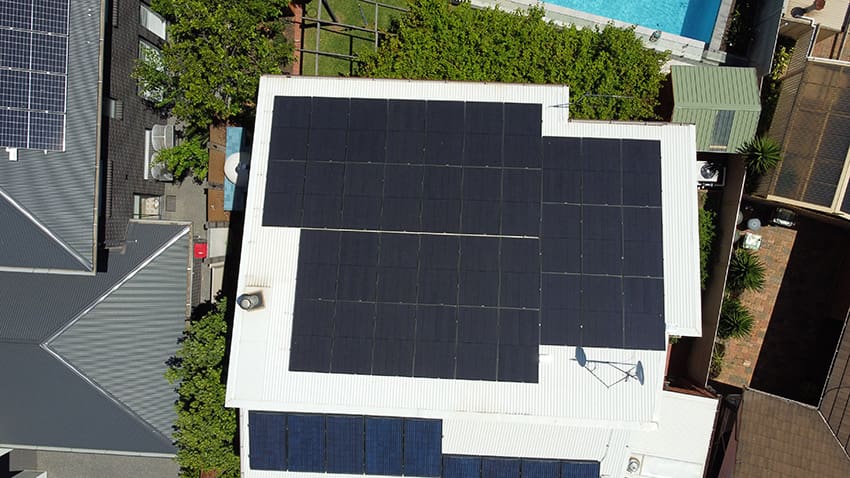
Older 6 kW system facing south, new 14 kW facing north (up).
If you have an EV, it makes sense to have a roof full of solar panels.
Why do you even need a dedicated charger?
Many EVs come with a portable charger that plugs into a regular powerpoint. If your car doesn’t come with one, you can buy one for a few hundred dollars.
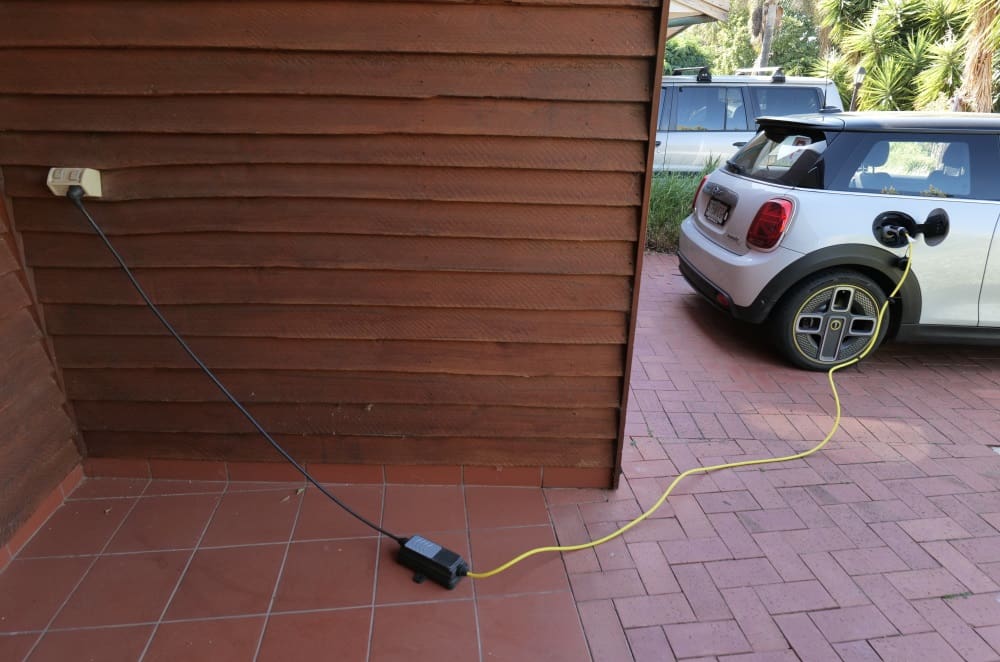
My electric Mini and its portable charger
These ‘trickle chargers’ can happily charge your car – slowly.
So why should you spend more on a dedicated wall charger?
Dedicated wall chargers charge three to ten times faster than trickle chargers, depending on whether your house is single-phase or three-phase and how fast your car can charge from AC power.
That allows overnight charging from flat.
Can’t you use public charging stations if you need to charge fast?
Home charging maxes out at 22 kW AC. Public fast-charging stations can go up to 350 kW DC.
That’s 350 km of range in as little as 10 minutes.
It’s not unheard of for some EV owners to trickle charge at home, and if they need to charge fast, they can go to a nearby public charger.
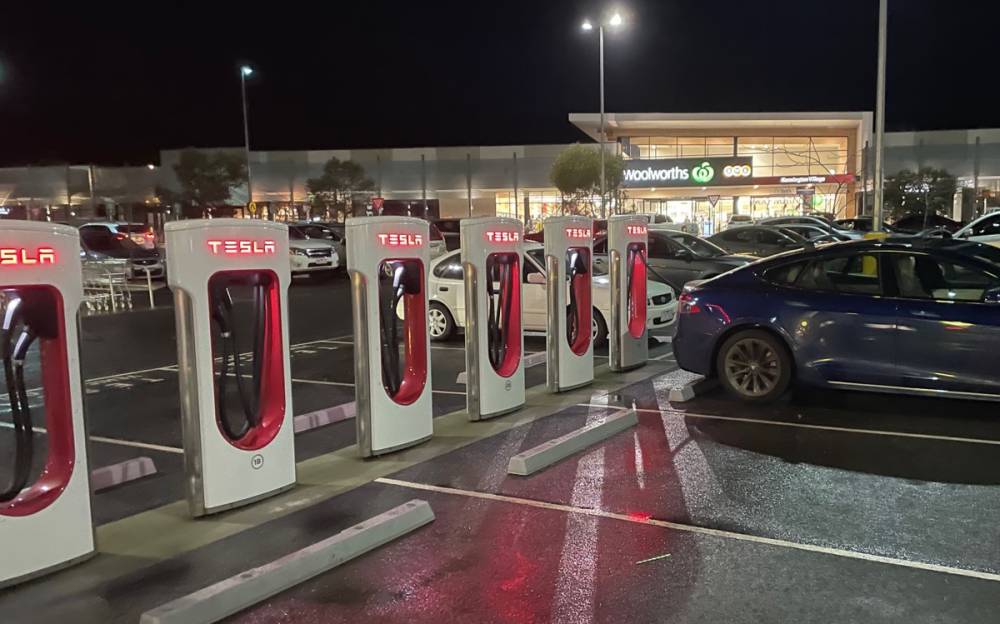
A bank of Tesla superchargers
But fast public chargers can cost 60 cents per kWh or more – double the price of grid electricity.
Relying on public fast-charging stations in place of a home charger is inconvenient and expensive – unless you only need to fast charge once in a blue moon.
Okay – so why not buy a cheap home charger?
While a cheap, ‘dumb’ EV charger will charge your car faster than a trickle charger, it won’t sync with your solar, battery or electricity tariff.
It’ll charge your car at full speed whenever it’s plugged in, even though electricity may be cheaper a few hours later.
This means you’ll pay way more for charging than you need to.
Pricier ‘smart’ chargers can automatically charge from cheap electricity (solar or grid), avoid expensive peak pricing periods, and avoid dumping your home battery’s energy into your EV.
What features should you look for in a ‘smart’ charger?
First and foremost: OCPP compatibility
OCPP stands for Open Charge Point Protocol. It means third-party services can control your charger.
It future-proofs your charger.
One example: Some electricity retailers may offer a cheaper EV charging tariff if they can control your charger via OCPP to avoid charging during wholesale price spikes.
Second: Untethered
Most chargers have both a tethered and untethered option. Tethered ones come with a built-in cable.
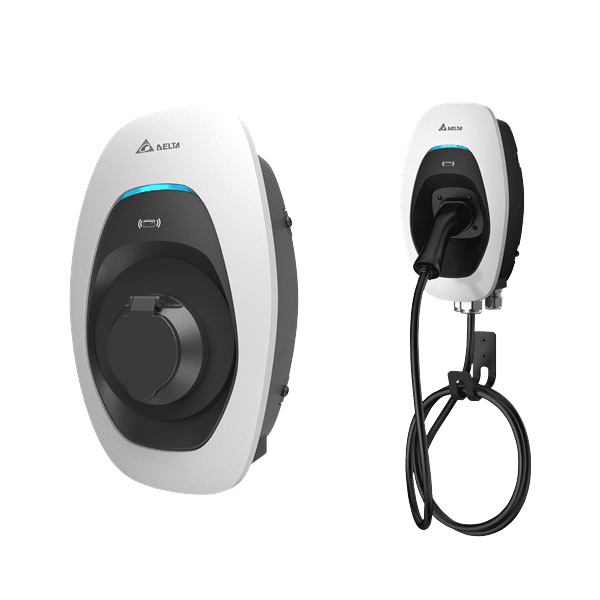
Untethered (left) and tethered (right) variants of the Delta AC MAX
As a result, they cost more, and the longest cable I’ve seen a tethered charger come with is 7.5 meters.
I bought an untethered charger and a ten-meter ‘type 2 to type 2’ cable.
It’s long enough to reach the second car in my driveway no matter which way it’s parked, and saves a lot of car shuffling.
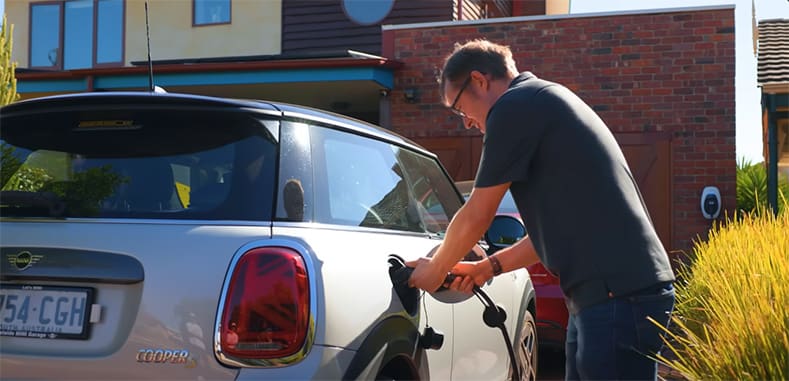
Thanks to my 10m cable, I have no problems charging two EVs in a long driveway.
Third: Solar charging
If your car charges during the daytime, your solar system will offset its usage.
However, if your charger pulls 11 kW and your solar only produces 5 kW, the grid will provide the remaining 6 kW. This is great for fast charging but not so great for your bills.
EV chargers with smart solar charging functionality can be set to only charge your car from excess solar.
Fourth: Three-phase
Single-phase home EV chargers can charge at a maximum of 7 kW, while three-phase chargers can charge at a maximum of 22 kW.
The speed at which your car can charge on three-phase depends on the model. Current Teslas charge at 11 kW on three-phase, but BYDs can only charge at 7 kW AC—even on three-phase.
My advice: get a three-phase charger if your house has three-phase power. It’s only a few hundred bucks more, and even if your current car can’t use the extra charging speed, it future-proofs your home charging.
What will an EV charger cost you?
Good quality, dumb EV chargers can be purchased for about $800.
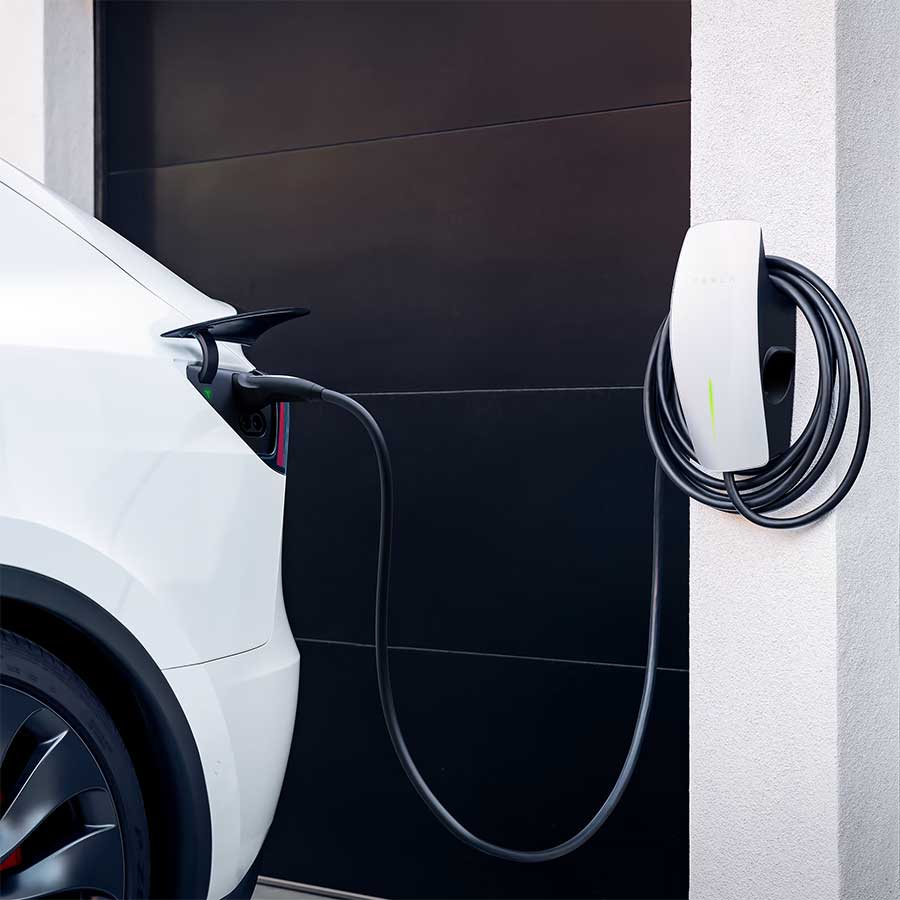
Funnily enough, a Tesla wall connector is a ‘dumb’ charger – but it’s reliable and low-cost (~$800). Although Tesla has told us, it will become smart soon via a software update.
Fully featured ones cost $1500+
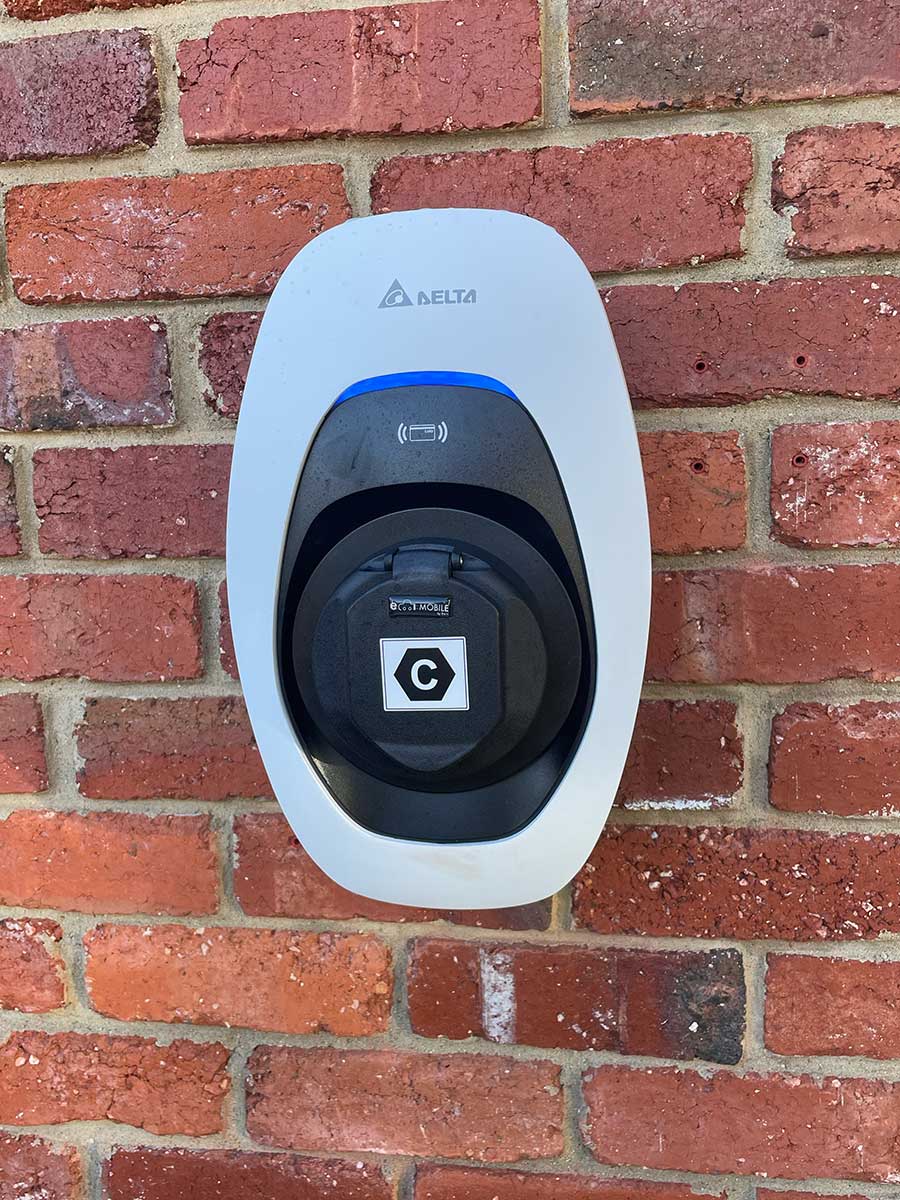
My untethered Delta AC MAX charger (cost $2,000)
My EV charger comparison table shows specs and pricing for all major products available in Australia.
What do chargers cost to install?
This depends on the difficulty of the charger’s installation. Installation costs for a simple single-phase dumb charger right next to a spacious switchboard could be as low as $300.
Costs can climb into the thousands for more complicated installs involving long cable runs and solar/battery integration.
The typical home can expect to pay about $1000 for installation, plus the charger cost.
Home batteries should be for your home, not your EV.
To use the Tesla ecosystem as an example – the Tesla Powerwall battery can store 13.5 kWh. The cheapest Tesla Model 3 has a 57.5 kWh battery.
Home batteries are much smaller than EV batteries. Dumping all of a Powerwall into a Model 3 will only charge it by 24%, leaving you no energy to get your home through the night.
Meanwhile, the typical Aussie home uses 16-30 kWh daily (excluding EV charging).
The 13.5 kWh of Powerwall storage is far more valuable in your home, where it could power close to 100% of your overnight demand.
If your EV charger doesn’t have the smarts to avoid draining a home battery, there’s a simple wiring change your installer can make.
What are some of the best chargers on the market?
I surveyed my network of ~500 installers and asked them 1) what EV chargers they’d buy if money were no object and 2) if they were on a budget and every dollar counted.
The Fronius Wattpilot easily won the ‘money’s no object’ category. But it only makes sense if you already have a Fronius inverter.
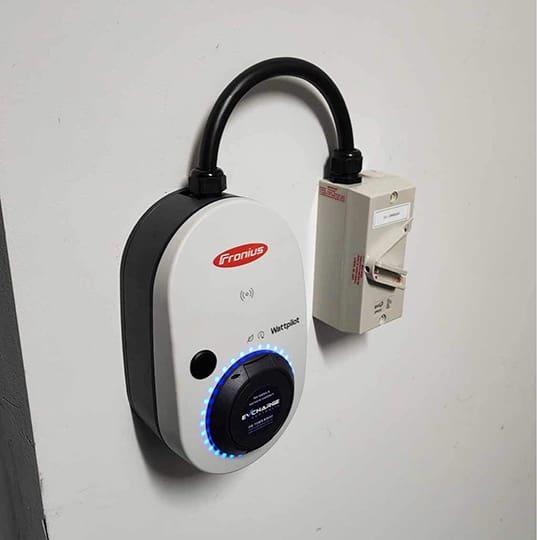
Fronius products have a fantastic reputation.
Tesla’s Wall Connector won the ‘every dollar counts’ category.
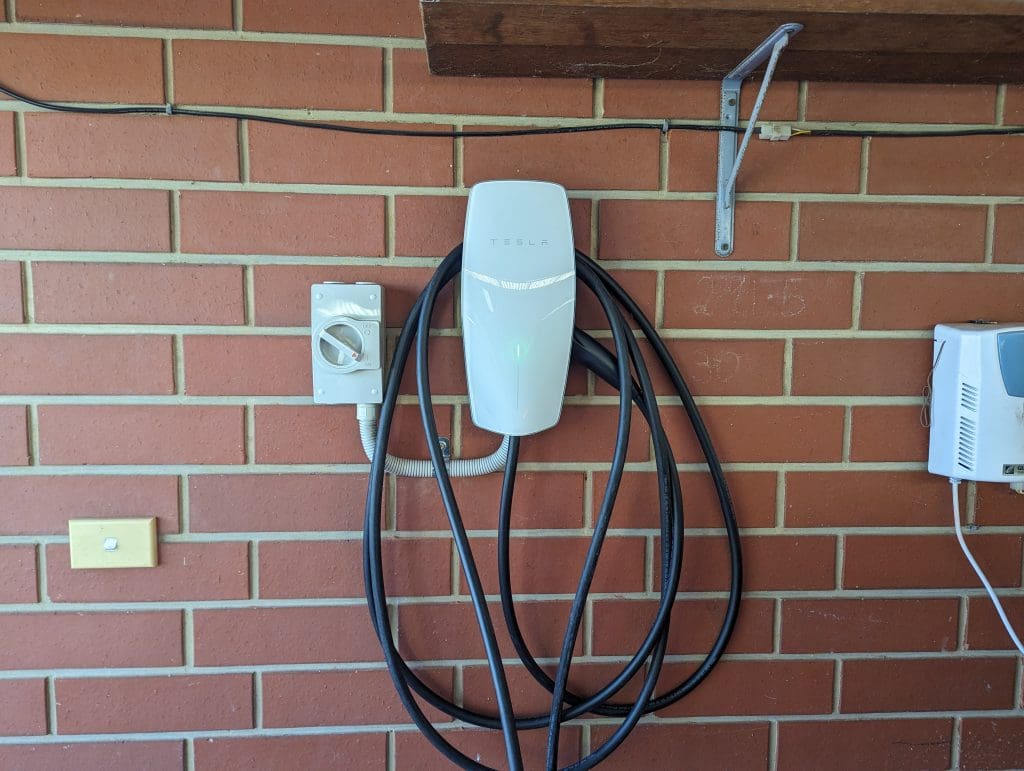
It’s strange, but welcome to see a Tesla product win a budget category.
For brands I recommend – I’ve put together the following chart:
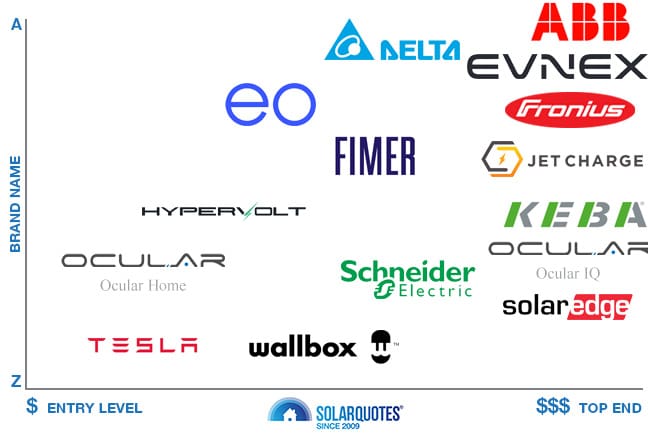
I’d be happy to recommend any of these brands to a friend.
Can your car power your home?
Many EVs allow you to power an appliance from the car’s charging port (known as V2L or Vehicle to Load), but to power your home (V2H, or Vehicle to Home), you need an expensive “bi-directional” charger.
The only bi-directional chargers I know of in Australia are the Wallbox Qasar ($10,000), and the Sigenergy DC EV charger (~$8,000). The only compatible electric car is the Nissan Leaf Gen 2.
This will change, but for now, V2H is rare as hen’s teeth in Australia.
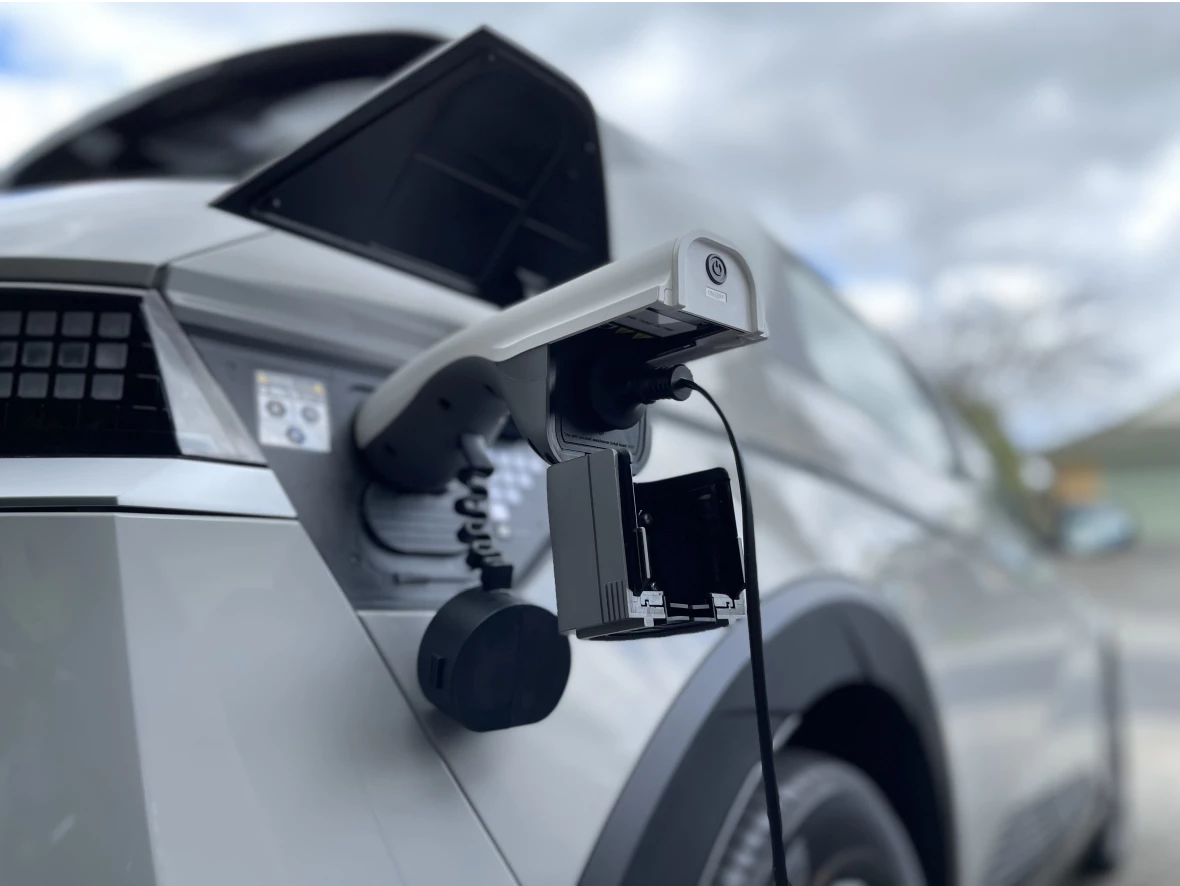
A Hyundai Ioniq 5 with V2L adaptor, giving it regular powerpoint you can plug into. Image credit: Hyundai NZ.
Wrapping up
My advice:
- Get a dedicated smart home charger, and configure it for cheap charging.
- If you can charge during the day (even if only weekends), max out your roof with solar.
- Properly integrate your charger with your home battery.
If you’re looking to get quotes for an EV charger, I’ve got a network of hundreds of expert installers in Australia. Simply fill in my form for up to 3 competitive quotes for EV charging that’s integrated with your solar and battery.
Footnotes
- Although home DC chargers will soon be available – subscribe to our YouTube channel to see Adelaide’s first DC home charger install in a couple of weeks ↩

 RSS - Posts
RSS - Posts



Extremely useful, thanks Finn. As somebody without 3-phase at home, do you have a piece here somewhere about the pros and cons of considering that, in relation to solar, charging etc.?
Hi Nick,
There’s a few articles here that will help explain
https://www.solarquotes.com.au/search/?addsearch=3%20phase%20battery
https://support.solarquotes.com.au/hc/en-us/search?utf8=%E2%9C%93&query=three+phase
We installed our Zappie single phase charger 4 years ago in 2020. We are very pleased with its performance and its ability to manage solar vs grid.
We mostly charge in daytime usually 8-10% charge and occasionally 70% charge after longer trips.
A bit disappointed you did not review Zappie chargers in this very interesting article.
Hi Terry,
Finn has some history with Zappi, both with their warranty support and legal threats they made after SolarQuotes told the truth about it. I know there are happy customers using them but our experience hasn’t been stellar.
That’s unfortunate, a lot has changed at myenergi since the V1 zappi, both with the product and operations in Australia. They are highly rated by Solarquotes customers and installers, including a gold medal for their technical support in 2024, perhaps as a result of recent change.
Would Solarquotes be open to rewriting ‘history’ to better reflect the experience of their wider customer base?
Compatibility of SolarEdge EV charger, SolarEdge Home Battery and Origin EV Power Up
In order to access the recent beta version of Origin energy EV power up product which allows me eight cents per kilowatt to charge my car, I’m having difficulties with the compatibility of this product and my EV charger and home battery from SolarEdge.
Unfortunately, I haven’t found a way to use any of the software features from SolarEdge without that interfering with when Origin decides to charge my car.
As a result my home battery is dumping into the car whenever the EV charger turns on.
I’d really appreciate any assistance to resolve this, whether that’s lobbing SolarEdge to make a fix or discussing options that may already exist.
Thank you, love your webpage.
Hi Andrew,
Talk to https://www.facebook.com/brent.heber/ and see what Solar Edge can do. These sorts of compatibilities are going to be a problem so it’s down to customers to raise them as they occur.
Or try Benjamin Cox on 0435 854 094. He’s very proactive in my experience.
Unfortunately that Facebook link doesn’t seem to work for me.
I have had similar problems interfacing a SolarEdge system with Amber. The Excess Solar mode on my SolarEdge charger worked fine until I signed up for Amber’s EV charging program Amber4EVs. This has coincided with several weeks of very low daytime solar prices.
Solar export price goes negative so Amber implements Solar Curtailment which ramps inverter output down to zero to prevent me exporting at negative prices. Charger sees zero inverter output so doesn’t charge my car.
SolarEdge blames Amber because they say Amber has control of my inverter so can’t do anything about it. Amber says they will have excess solar capability in A4EVs but haven’t got that working for me yet. So I’m in limbo between SolarEdge and Amber with no excess solar capability on my charger.
Finn,
first, one disadvantage of plug in ´Granny chargers´ is they are hard on power points. I have replaced many over my 10+ years of charging the Imiev. The issue is the leads pull on the plug (as in your photo) & because they draw a constant 10A, they warm up. Eventually they melt….
Granny chargers are good for emergencies I feel. They should use the ring retained industrial plug for reliability. Only use really heavy (2.5mm sq) Extension leads, & definitely no loops! Keep Extensions under 15M, & preferably never use!
I have a fixed ZJBeny OCPP charger managed by Home Assistant Energy Management system (Open Source). Very good value charger. 6M Tethered
lead. (Untethered available).
Next year there will be DC chargers available for home use (Bi-directional)
Solar Edge have just announced one for next year. (Cost tba)
One thing is The World she is a Changing! Viva la future!
Hi Doug,
I’ve melted a few plugs & sockets myself…
https://www.solarquotes.com.au/blog/ev-charging-power-outlet/
Great article, Finn! Very informative.
My question – when do you think bi-directional chargers (and the EVs to use them) will become more readily available (and at more reasonable prices!)?
Hi Ross,
As day follows night, solar gets cheaper, and bi-directional charging is coming. We need it for network stability.
Thanks Anthony – yes, there is no doubt it IS coming……the big question is when! I already have 7.8kW solar on the roof, 3 phase power supply and Fronius inverter. I am teetering on the edge of buying more solar, home battery, EV and charger….so timing and availability will be big issues for me!
Hi Finn,
During your video, a list came up with your electricity prices, hour by hour for the whole 24 hours. Can I get one from my retailer Origin?
Hi Eric,
Best to approach Origin about that, if they’re offering TOU prices then they’re obliged to tell you when.
Is the 7 kW charging rate for single phase an Australian regulatory limitation (push) or is it an EV limitation (pull)?
In the US there’s a rule that any circuit must only be used to 80% of its max amperage for a prolonged period. Is there an Australian equivalent rule?
So, at 7 kW max then that suggests 7,000 / 230 = 30.43 Amps, so following the US 80% rule (not knowing if/what Australia has) would imply a 40 Amp circuit/breaker.
Any suggestions where to read up would be appreciated.
Hi Ram,
Australian electrical guidelines are similar insomuch that circuit protection should have headroom over and above the rated load, and it’s the circuit protection that dictates cable size (along with voltage drop)
Many sparkies run a rule of thumb 32a/6mm² circuit for EV charging and it’s not enough.
We recommend a 40a supply
What’s more interesting is that Schneider & Hager have guidance out that says if the switchboard is packed, with no air gaps for heat dissipation between circuit breakers, then the circuit should be rated for double the nominal load to deal with components being heat soaked. ie 63a for a 7kW charger!
Thank you.
So it sounds like an EV limit of the 7 kW for single phase AC.
Given the relatively immaterial cost for higher capacity wiring – I cannot understand why electricians don’t make a point of recommending much higher capacity not just for EV charging but also solar panel installations.
When I looked into this before adding panels to our roof there seemed to be only a slight difference in what there was to be gained from using double the diameter wiring (apart from it potentially being harder for the installer to run down through cavity walls).
The lower resistance (heat) due to the 4x capacity provided seemed to be agreed to add between 1 to 3% additional power output. The additional cost for the much higher capacity wiring vs the value from 1 to 3% additional generation provides a very short payback.
Surely it should be a selling point for a good electrician/installer?
Another factor in the decision process is that portable chargers can be claimed if you have a novated lease whereas wall chargers cannot.
This makes a good case for installing a 32A plug and purchasing a 22kW portable charger.
I have a single phase OCPP charger station and make use of solar PV charging and scheduled charging for super off-peak periods. While it can deliver ~ 7 kW, the reality is we rarely need our car to charge that quickly. We just don’t drive enough km (we drive a bit over the national annual average of km/year).
Super off-peak tariff plans are where a dumb charger can still do quite OK as a charging schedule can be managed by most car’s on board systems. No real need for a smart charger in these cases, the car is already smart enough.
Even a basic but decent quality 2.3 kW plug in charger (using an appropriate power outlet) is sufficient for most commuter needs.
Combined with the car’s own charge schedule control and super off peak tariff offering 6 hours overnight of very cheap power, that’s still able to deliver ~80 km of range. Very low cost of equipment and using the facilities you already have. Or a little bit more for 3.6 kW. For a lot of homes this will be plenty fast enough.
Unless you drive big miles each day, it takes a long time to benefit from spending the extra couple of thousands of $ just to have a faster home charger.
For those who can charge from solar PV like we can because the car is often at home during the day, well several EV tariff plans now exist which are offering free energy in the middle of the day anyway, which is even cheaper than foregone solar FIT credit.
These super off-peak/free energy plans negate the need for solar charging smarts (just ask ChargeHQ how that’s going).
2 or 3 hours free even with a low power charger can still add decent range, while solar PV is easily going to cover daytime demand from a low power charger when it’s sunny.
None of this is to say these smart higher power AC EV supply equipment are not good things, but in many cases it means are spending a lot of $ for not a lot of gain, when a perfectly adequate, cheaper and effective option already exists.
Perhaps worth adding a link to Tesla’s “Charge On Solar” post https://www.solarquotes.com.au/blog/tesla-charge-solar-mb2990/
And also mention their upcoming V2H support https://www.solarquotes.com.au/blog/tesla-confirms-key-powerwall-3-specs/
I just bought my parents a 15Ah charger as they wanted something slightly faster than the trickle charger that came with their EV, and already had a 15Ah plug, so was the perfect gift given it is a 50% improvement.
The only issue is the 5M length I bought struggles and they have a 30M motorhome 15Ah rated extension cable, this is fine to use I assume as they are rated the same?
Otherwise it just won’t reach.
I’ve read a mixture online some people swearing it is okay as long as you do the right thing and some others quoting that the manufacturer states no, but is this only to cover their hides from stupid people not using the correct spec equipment for the job?
Here is our best advice on extension cords and EV chargers:
https://support.solarquotes.com.au/hc/en-us/articles/6375984912015-Can-you-charge-an-EV-with-an-extension-cord
TLDR: if you must, get a screwed socket fitted, and an extension cord made up by a good electrician.
Thanks Finn for your articles, and for those responding, certainly helps trying to get our head around this.
We are increasing our solar to 11kw.which will max out useable roof space. We have a Goodwe Inverter with Tesla
powerwall 2. We want to add another Ppwerwall 2 when we add the additional panels. We also want to add a EV charger (EV still to be ordered).
Installer is also learning (but want to stay with them) They have quoted on Goodwe charger. Should we go with this as as we have the Goodwe Inverter or should we choose an OPCC compatible unit?
We want to use solar where possible as we already have excess. TIA.
Hi Trish,
I’ve heard good things about the Goodwe EV charger, and it can do solar smart charging with any EV by talking to the Goodwe inverter. But it’s not OCPP compatible. This will be a problem in the future if you want a third party to control the charging of a non-Tesla EV, for example if you use an electricity retailer that gives you cheap EV charging in exchange for control of your charger.
If you only ever want to solar-smart charge – the Goodwe is a good choice.
If you buy a Tesla EV, then the Powerwall(s) will talk direct to the car to do solar smart charging, and time-based control of ToU tariffs (if applicable to you) – so you could use any EV charger – including the Tesla which has twice the warranty. Tesla have promised that their EV charger will be OCPP compatible via a software upgrade soon.
So in summary – if you only want to solar smart charge any brand of EV, Goodwe is a good choice. If you will only need to charge a Tesla EV, the Telsa EV charger is a better choice IMO. If you want to charge non-tesla EVs and have OCPP, let me know and I’ll find an EV charger that can solar smart charge and has OCPP.
Thanks so much Finn for your detailed response. If you could suggest a charger that can solar smart charge and has OCCP that would be appreciated. Also from reading above perhaps untethered.
As an FYI, not looking at a Tesla EV. Possibly Zeeker x. Thanks again for all the info you provide, helped with our decision to add another Powerwall V2 rather than the newbie…
Consider a Wallbox EV charger: https://www.solarquotes.com.au/ev-chargers/reviews/wallbox-review.html
They are OCPP compatible and can do solar smart charging.
Think about whether you want your home batteries to be able to discharge into your car, and ask the installer to wire it such:
https://www.solarquotes.com.au/blog/ev-draining-home-battery/
Thanks for the info Finn, greatly appreciated. Just now to decide which way to go, wallbox or Good-we. Just a question though, I thought from your post it was unwise to discharge battery into the car,. Can you kindly clarify?
2x Tesla Powerwalls holds about 17 kWh, whereas an EV typically has a 70 kWh+ battery. So it’s easy to drain your home battery into your EV. This depends on how much daily driving you do. If you only drain the EV a few kWh per day, using the Powerwalls to top up can make sense.
If you empty your powerwalls into your EV, you’ll have no battery energy left to power your home through the expensive evening and/or monring peaks.
Wear and Tear: Batteries wear out faster with more frequent use. Regularly using your home battery to charge an electric vehicle could accelerate its degradation. Although Powerwalls have an unlimited cycle warranty – which should put you at ease for the first 10 years!
It’s generally more economical to use solar power directly or off-peak grid electricity for charging your EV rather than draining your home battery, because you can time your EV to charge when electricity is cheapest.
Thanks for the info on the battery, well explained!
Hi Trish,
I’ve had at least one good operator I know who sells Fronius packages as his primary offering, but he really rates the GoodWe solar and EV charger for the budget option.
We recommend you try and stay in an ecosystem so that you don’t have to integrate different gear and you can keep it all under the same app and compatible management.
Tesla’s wall charger is coming with OCPP 1.6j and then the more secure version 2.0 shortly thereafter they tell me. I’m inclined to think the battery is the most important thing you need to preserve by not draining it into the EV. Usually people do this using charge HQ to control it, but there’s a subscription to pay there.
Your GoodWe solar and charger should play well together but I’m not sure what the options are for prioritising what energy goes into what vessel at what time.
Sometimes it’s just a matter of putting the measuring devices in the right order to get a hierarchy established, (the EV charger usually goes outside the Tesla gateway) but you’ll need to talk to the installer and maybe get a line diagram organised to make sense of it.
Hi Anthony
What you say really makes sense, and for the reasons you have stated might just stay with the Goodwe So a line diagram is a fab idea as it will ensure the installer confirms what we want will be delivered as they are learning too. I have asked Finn for any other suggestions but with technology I really like to keep it simple.
I’ve got a Mitsubishi Outlander which only has a 3.5kW onboard charger so a 15A granny charger maxes it out, so that’s what I use. Only takes 4 hours to charge because the battery is small too. But if I did decide to get a smarter charger does the OCCP stuff work with a car using a type 1 plug? (Includes Toyota Prius etc). Say I got an untethered charger is it ok to use a type 2 to type 1 charging cable? Or should I rather wait until home DC charging is available? (although no doubt that won’t be for Chademo cars). I’ve got Fronius inverters and Tesla PW2’s.
Hi Mark,
I’ve got the same outlander, but mine doesn’t even have a CHAdeMO plug on it. The wall box Quasar 1 is a full bidirectional charger that you can use with CHAdeMO, but for 10 grand, I don’t think you’d be interested, if they’ve still got stock of them.
I’ve never tried dynamic solar charging using a type one socket, but I imagine that it would work. The other option is simply to have a dedicated circuit for your granny charger, which switches on and off at a given threshold of sunshine. You could set up a thronius inverter to control that, provided there’s a consumption meter on site. However, I don’t know if the Tesla Powerball has a suitable dry contact output.
Thanks Anthony, I’m retired and the car isn’t used every day so I can just keep manually picking my charging times when the sun shines. I’ll wait till the bi-directional chargers finally get approved and see what products emerge. The Outlander battery is about the same size as a PW2 so I’d be prepared to pay up to ~$10k (including install and integration) for a unit so long as it was Chademo compliant. Chances of that happening are low I would think. I like the Outlander but it was certainly a mistake four years ago thinking that V2G was just around the corner
Hi Mark,
It’s been available and we have a few articles on it. Now AS4777 has been updated there will be more but CCS2 standards are the next stumbling block.
You could look at a Sigen system but that’s not CHAdeMO
https://www.solarquotes.com.au/blog/ev-v2g-sa-mb2764/
I noticed that in many EV charger installation photos an isolation switch has been included in the set-up. Is this a required component or is it an extra safety mechanism? I’m about to have a solaredge EV charger installed within 3M of my switchboard and would prefer not to have the isolation switch due to a lack of space and aesthetics.
Technically, you do not need an isolator for your EV charger installation in Australia.
More details here:
https://support.solarquotes.com.au/hc/en-us/articles/6815668465807-Does-a-hard-wired-EV-charger-EVSE-need-an-isolator-for-the-supply-wiring
The electrician who installed my Wallbox charger last year included an isolation switch next to the charger. He said it was mandatory but I would have agreed to it even if not mandatory. The Wallbox has no manual switches – all control is via software – so I prefer the availability of an emergency off switch nearby.
Hi Michael,
AS3000 treats EV chargers as a glorified extension cord so isolators aren’t technically required.
Most pragmatic electricians fit one because it makes service & terminations easier when dealing with 10mmsq cable. For a few extra dollars (or as needed with a Wattpilot Go) you can have a socket outlet fitted which means there’s isolation and customer serviceability
Hi…
we are about to install Solar panels on our shed roof.
We have no immediate plans for an EV,
tho we intend to buy one in the next 5-10yrs.
What allowance should we make now, for an EV charger,
in the system & also for a possible home battery, in the future?
… or are both those items easily added later (newer tech, lower price?)
thanx ..Brad
Hi Brad,
The first two links here probably explain a bit
https://www.solarquotes.com.au/search/?addsearch=switchboard
Bear in mind, if you’re putting solar onto a shed, you may need a decent sized power supply.
https://www.solarquotes.com.au/blog/shed-solar-distance/
https://www.solarquotes.com.au/blog/solar-voltage-rise-drop/
I recommend the EV Chargers are wired in 10mm² cable as a 40 amp circuit.